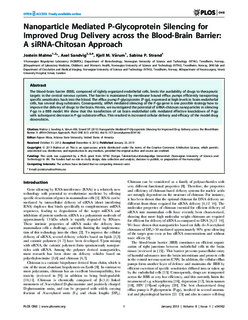| dc.contributor.author | Malmo, Jostein | |
| dc.contributor.author | Sandvig, Axel | |
| dc.contributor.author | Vårum, Kjell Morten | |
| dc.contributor.author | Strand, Sabina P. | |
| dc.date.accessioned | 2015-11-16T14:13:30Z | |
| dc.date.accessioned | 2015-11-17T14:35:51Z | |
| dc.date.available | 2015-11-16T14:13:30Z | |
| dc.date.available | 2015-11-17T14:35:51Z | |
| dc.date.issued | 2013 | |
| dc.identifier.citation | PLoS ONE 2013, 8(1:e54182) | nb_NO |
| dc.identifier.issn | 1932-6203 | |
| dc.identifier.uri | http://hdl.handle.net/11250/2360559 | |
| dc.description.abstract | Background:
Neonatal intermittent hyperoxia-hypoxia (IHH) is involved in the pathogenesis of retinopathy of prematurity. Whether similar oxygen fluctuations will create pathological changes in the grey and white matter of the brain is unknown.
Methods:
From birth until postnatal day 14 (P14), two litters (total n = 22) were reared in IHH: hyperoxia (50% O2) interrupted by three consecutive two-minute episodes of hypoxia (12% O2) every sixth hour. Controls (n = 8) were reared in room-air (20.9% O2). Longitudinal MRI (Diffusion Tensor Imaging and T2-mapping) was performed on P14 and P28 and retinal and brain tissue were examined for histopathological changes. Long-term neurodevelopment was assessed on P20 and P27.
Results:
Mean, radial and axial diffusivity were higher in white matter of IHH versus controls at P14 (p < 0.04), while fractional anisotropy (FA) was lower in the hippocampal fimbria and tended to be lower in corpus callosum (p = 0.08) and external capsule (p = 0.05). White matter diffusivity in IHH was similar to controls at P28. Higher cortical vessel density (p = 0.005) was observed at P14. Cortical and thalamic T2-relaxation time and mean diffusivity were higher in the IHH group at P14 (p ≤ 0.03), and albumin leakage was present at P28. Rats in the IHH group ran for a longer time on a Rotarod than the control group (p ≤ 0.005). Pups with lower bodyweight had more severe MRI alterations and albumin leakage.
Conclusion:
IHH led to subtle reversible changes in brain white matter diffusivity, grey matter water content and vascular density. However, alterations in blood-brain barrier permeability may point to long-term effects. The changes seen after IHH exposure were more severe in animals with lower bodyweight and future studies should aim at exploring possible interactions between IHH and growth restriction. | nb_NO |
| dc.language.iso | eng | nb_NO |
| dc.publisher | Public Library of Science | nb_NO |
| dc.title | Nanoparticle Mediated P-Glycoprotein Silencing for Improved Drug Delivery across the Blood-Brain Barrier: A siRNA-Chitosan Approach | nb_NO |
| dc.type | Journal article | nb_NO |
| dc.type | Peer reviewed | en_GB |
| dc.date.updated | 2015-11-16T14:13:30Z | |
| dc.source.volume | 8 | nb_NO |
| dc.source.journal | PLoS ONE | nb_NO |
| dc.source.issue | 12 | nb_NO |
| dc.identifier.doi | 10.1371/journal.pone.0054182 | |
| dc.identifier.cristin | 996489 | |
| dc.description.localcode | © 2013 Morken et al. This is an open-access article distributed under the terms of the Creative Commons Attribution License, which permits unrestricted use, distribution, and reproduction in any medium, provided the original author and source are credited. | nb_NO |
